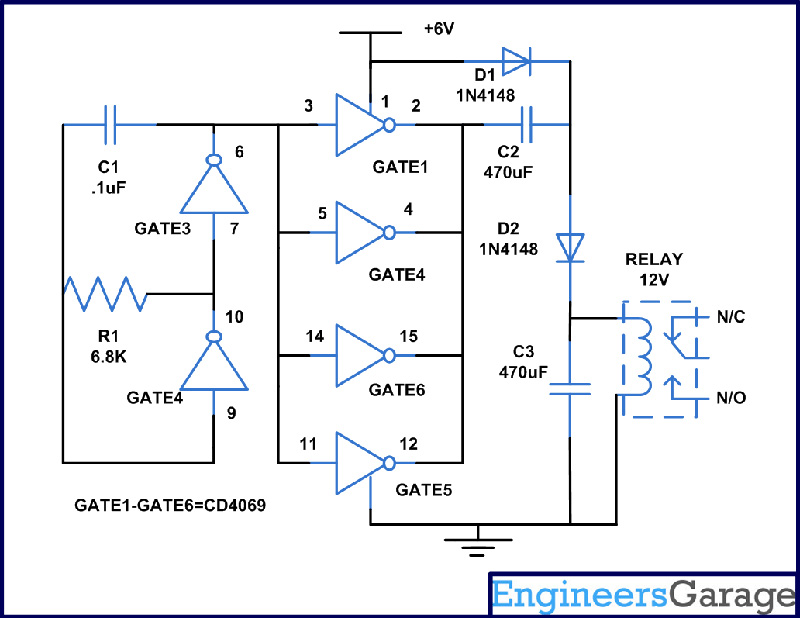The circuit described here would produce an output voltage having twice the magnitude of the input voltage. In this circuit, we are using 6 Volts as input supply and we are getting 12 volts as its output. It is based on the popularly used hex inverter CD4049 IC. This can be made with the help of single IC with few more components.
CD4049 contains six inverter gates in one package as shown in diagram. In this, pin 3 is input and 2 is for output. For first gate similarly pin 5 is input and pin 4 is output for second gate similarly we have four more gates. Pin1 1 is for supply voltage and pin 8 is connected to ground. Pin 13 and 16 are unused.
[[wysiwyg_imageupload:6731:]]
Fig. 1: Pin Diagram Of CD4049 IC with Six Inverter Gates
The voltage doubler circuit is based on NOT gate CD4049 IC. We are utilizing all 6 gates of NOT gate. To understand the working you should know about the truth table of NOT gate are as follows-
|
Input
|
Output
|
|
0
|
1
|
|
1
|
0
|
In NOT gate, we will get output as logic high when logic zero is provided and we will get logic zero when logic1 is provided in input.
CD4049 contain six inverter gates in one package as shown in diagram. In this pin 3 is in and 2 is for output for first gate similarly pin 5 is input and pin 4 is output for second gate similarly we have four more gate. In this 1 is for supply voltage and pin is connected to ground and pin 13 and 16 are unused pin.
In this circuit we are utilizing all six gates of NOT gate. Firstly we have made an oscillator with the help of gate 3 and 4, capacitor C1 and resistor R1. The frequency of oscillation is determined by the value of R1 and C1. The remaining gates are joined in parallel to act as a buffer. Input pins 3, 5, 14 and 11 are connected together and join to the frequency source from oscillator. Similarly we have connected all output pin 2,4,15 and 12 and terminated to voltage enhancer circuit.
A voltage multiplier circuit can be made with the help of a diode and a capacitor. This can be used to generate more output voltage than the supplied input. Here we are using most popular commonly used half wave series multiplier.
The requirement to make a voltage doubler circuit is 2 diodes, 2 capacitors and an oscillating voltage. As you can see from the circuit in this diode D1 is forward bias and conducts which in turns chare the capacitor C2 to the peak value of input voltage which now turns as a battery in series with the power supply. At the same time D2 conducts because of D1 and charges capacitor C3.Therefore voltage across C3 will be sum of supply voltage and voltage across C2. The main advantage of this voltage doubler circuit is that it allows higher voltage to be created from a low source without the need of a transformer.
Hence at the output of Diode D2 you can operate 12V relay with the help of 6volts supply.
Also check the Voltage Doubler Circuit using 555 Timer IC
Circuit Diagrams
Project Components
Filed Under: Electronic Projects



Questions related to this article?
👉Ask and discuss on Electro-Tech-Online.com and EDAboard.com forums.
Tell Us What You Think!!
You must be logged in to post a comment.